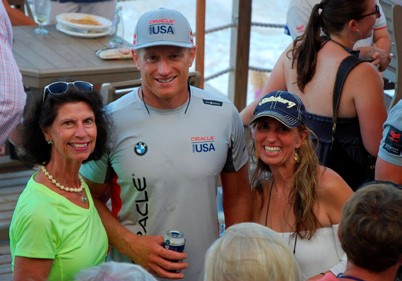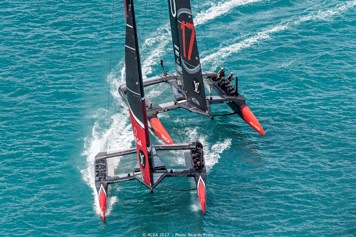By Lisa duBusc Miller
 Sure, there are plenty of cool colorful racecourse graphics and insightful commentary when you watch the world’s greatest sailing race on TV. But when those hydrofoiling winged AC50 catamarans are soaring right at you, across the Great Sound of Bermuda in the 35th America’s Cup, as you sway to and fro astride a luxurious spectator boat, with a Goslings rum swizzle in hand, and a warm salty breeze is blowing, nothing beats it.
Sure, there are plenty of cool colorful racecourse graphics and insightful commentary when you watch the world’s greatest sailing race on TV. But when those hydrofoiling winged AC50 catamarans are soaring right at you, across the Great Sound of Bermuda in the 35th America’s Cup, as you sway to and fro astride a luxurious spectator boat, with a Goslings rum swizzle in hand, and a warm salty breeze is blowing, nothing beats it.
The author (right) and her mother share a moment with ORACLE TEAM USA skipper Jimmy Spithill. © dubusc.com
In the words of ExperienceBermuda.com, the America’s Cup, which is held every four years, is the “pinnacle of international sailing, and has generated intense excitement and fierce rivalries for more than 160 years.” And “it is not only the oldest trophy, in international sport; it predates the modern Olympic Games by 45 years and is yachting’s biggest prize.” This year was the first time it has ever been held in Bermuda.
Rewind to April 30, 2016, when American Yacht Club in Rye, NY provided some up close and personal time to its members with the “Auld Mug.” Then a few months later, in July 2016, we were fortunate enough to get to spend time with ORACLE TEAM USA at Coral Beach & Tennis Club and their boat. It was around then that I made a personal pact to return to Bermuda in 2017 to see them defend the Cup, on this island full of my favorite childhood memories.
The pure physics of this particular regatta are difficult to comprehend. But we all do our best. These boats behave more like man-powered airplanes as they hover and glide above the sea, tacking and swooping like birds in the deep turquoise waters off of Royal Naval Dockyard.
We flew to Bermuda on June 14, landing amidst Day Two of the SuperYacht Regatta over on the St. George’s side of the island. Although we had planned to take an official spectator boat out to watch them, the boat broke and could not be fixed in time. Ah, island life…So, we decided to relax on the pink sands of Coral Beach Club instead.
ORACLE had the day off, so we spent quality time with team member Juan Vila, who is a friend of the family. Juan is meteorologist and tactician, and he rides in the first chase boat during the races. Juan is also “possibly the best and most experienced Spanish sailor of all time. Winner of some of the most important sailing events worldwide he is the only Spanish competitive sailor to have won both a round-the-world race with stopovers (Whitbread/Volvo Ocean Race) and the America’s Cup. As if this was not enough, he broke the Jules Verne record (‘round the world non-stop) on board the maxi-trimaran Banque Populaire,” according to Trofeocondegodo in May 2012.
Spending time with Juan, a Barcelona native, it was impossible not to think about how few Americans are actually on “the American team.” Perhaps the rules will change and going forward, teams will be comprised of nationals only. We will see.
We headed out the next day, June 16, to watch the J-Class boats, but there was not enough wind for racing, so we just enjoyed the jovial camaraderie aboard the sailboat. As we motored around this “coral cap,” as our Captain refers to Bermuda, he educated us on how a volcanic eruption mixed with the winds, temperatures and currents of the Gulf Stream to create this, the most northern coral island in the world.
Captain Bob – whose family’s been in Bermuda for 300+ years – proceeded to regale us in his lovely Bermudian lilt, with maritime wisdom. He told us about how Bermuda was discovered by Spanish pilot Juan de Bermudez in 1505. He also touched on the sinking Sea Venture coming upon Bermuda in 1609 after a hurricane. The story of salvation of those aboard and their miraculous arrival on two small ships the following May in Jamestown, VA is widely thought to be the inspiration for Shakespeare’s The Tempest.
Bob also described the “thick slurry of lyme” created for use in the island’s signature limestone roofs, designed to collect rainwater. This is how the island gets all of its water. He delved into a discussion about the endangered cedar trees, crystal caves, and that magical grotto at the entrance to the old Castle Harbour Hotel, which brought me right back to age 8.
I, in turn, found myself reminiscing about sea slugs and champagne bottles that my brother Bentley and I used to find at the bottom of Harrington Sound. They were remnants of when my grandparents’ “Harrington House” used to be called Harrington Hotel and guests gleefully tossed half-empty bottles over the coral wall into the water in the 1940s. It was on that very same wall, on hot summer nights, that I sat with my mom and grandma in the 1970s and ‘80s, eating ice cream and searching the sky for shooting stars.
For Day 1 and Day 2 of America’s Cup Match presented by Louis Vuitton, we boarded America’s Cup ferries, spectator sailboats, catamarans and even managed some time aboard a floating pirate ship (Calico Jack’s) in Dockyards, complete with “walk the plank.”
Yachts of all shapes and sizes surrounded us, and I recalled when my grandfather would walk me into the Royal Bermuda Yacht Club for lunch during a workday in the ‘70s. I’d smell the cedar rafters and doors and think nothing of his knee high socks worn with shorts, coat, and tie, as I’d gaze at the rows of sailboats docked in Hamilton Harbour.
Aboard the spectator boat, we reveled in the atmosphere and variety of boats surrounding us now, here at the America’s Cup: everything from Ross Perot’s 39-foot Buzzi RIB to Charles Simonyi’s luxury 233-foot yacht. The atmosphere was one of genteel majesty and the sun was so hot, the beverages so refreshing, the turquoise water so inviting, and the limestone roofs atop pastel homes dotting the shoreline, so charming. It all mixed together and allowed us to feel a heady America’s Cup high.
 Between the regalia and relaxation, we noticed ORACLE has had a few missteps: losing precious time up on foil, incurring various penalties, and not keeping their speed up while foil tacking and jibing. We all bristled whenever the hulls of the ORACLE boat came off foil and touched down, causing unstable flight.
Between the regalia and relaxation, we noticed ORACLE has had a few missteps: losing precious time up on foil, incurring various penalties, and not keeping their speed up while foil tacking and jibing. We all bristled whenever the hulls of the ORACLE boat came off foil and touched down, causing unstable flight.
Emirates Team New Zealand so thoroughly had the measure of ORACLE TEAM USA throughout the 35th America’s Cup Finals that the defenders were lucky to win one race. ©ACEA 2017/Photo Ricardo Pinto
And yes, we speculated – along with the rest of the world – about whether the decision by the New Zealanders to bank on bigger leg muscles to power their boat’s hydraulic system would pay off. They certainly took an innovative gamble by swapping out the traditional arm-powered winches with cycle-style grinders to provide power to raise and lower the foils and pull in the huge wing-sail. This had the added benefit of keeping their hands free, leaving less in the hands of helmsman Peter Burling and wing trimmer Glenn Ashby.
The shape of their daggerboards, favoring light wind conditions, might’ve factored in, too. But it was all just banter and speculation on our part. But, as is commonly said, we all can agree that this race has become a technology race almost more than anything else.
So, in spite of a few exhilarating moments of potential, ORACLE TEAM USA had fallen behind the Kiwis, giving up all four races – over the course of both days – despite all our cheering from the spectator boat lineup.
We numbed the pain after Day One by dancing it away to music by Alison Hinds, the Queen of Soca, in the America’s Cup Village, then ate a somewhat somber dinner with ORACLE team members at The Frog and Onion in Dockyards. We left to catch the last ferry to Hamilton to enjoy live music at The Hog Penny pub and dancing at Café Cairo.
I headed home from Bermuda to Rye, New York while ORACLE TEAM USA spent the next week (June 19-24) shedding about 200 pounds off of their AC50, according to skipper Jimmy Spithill. And under his watch, ORACLE managed a critical win in their effort to defend the Cup, maneuvering in shifting winds in the 6th race on June 24.
I watched the Kiwis win the Cup on TV in my kitchen in Rye, and could almost taste the Goslings, smell the saltwater, and feel the boat sway. Almost.
Lisa duBusc Miller was born in Greenwich, CT. She has traveled around the world and written about her adventures. Her articles have been published in The Rye Record, The Rye City Review, Global Living Magazine, Indagare Magazine, Eastern Surf Magazine, The Greenwich Citizen, The Examiner News, Whalebone Magazine, The Pingry Review, Bucknell Magazine, and Scuttlebutt Sailing News. She lives in Rye, NY with husband, three teens and two dogs.




